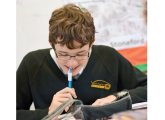The reforms of recent years emphasised that all teachers are accountable for all children in their class, including students with SEND. However, schools must help staff build the knowledge and understanding to achieve this.
At Priestnall – a truly comprehensive secondary school with over 1,200 students, where I am director of curriculum support, SENCO and specialist leader of education – we have developed a saturation model that looks at how we can create a more emotionally regulated environment for young people with complex disabilities. Sometimes this can be as simple as developing quality first teaching strategies; moving a child to the front of the classroom, as this can make learning more accessible. And other times it can involve more complex strategies, such as involving bespoke timetables and specialist therapies.
Occasionally, there will be a child in the classroom who, despite the environment being emotionally regulated, still finds it difficult to engage. At this point, we can then undertake further observations and assessment and look for the root cause of what is making it difficult for that young person to access learning in that environment. We can then work collaboratively with parents/carers and other professionals in developing new pathways towards mutually agreed outcomes.
It’s crucial that we record and monitor any classroom changes and progress so that the impact of provisions can be seen as part of the ‘assess-plan-do-review cycle’. This enables teachers to make changes based on the evidence and try alternative methods, including implementing interventions and support.
Involve the student
Young people must be at the centre of, and involved with, discussions surrounding their education. Individual education plans work well, but only in settings that include students in the process, rather than impose the plan/ generic targets on them.
We use ‘student passports’ to engage in discussion with our parents/carers and young people. It’s a simple document with a photo of the child, talking about what the child wants, and detailing their disabilities and needs, but it also includes an agreed strategy for the young person, the teacher, the school and the parent or carer. We make this process entirely inclusive by opening up the communications between parents/carers, students and staff and we’ve built this into our whole school model for teaching and learning.
Bananarama principle
I am a huge advocate of the ‘Bananarama Principle’ coined by Professor Steve Higgins from Durham University because it recognises that “it ain’t what you do, it’s the way that you do it”.
This means, quite simply, that what works for me in my school, might not work for you in your school. It’s all about trialling until the best fit is found and, often, being creative can lead to successful outcomes.
At Priestnall, for example, we ran a series of dog training sessions as an after-school club for eight of our students, because there is a growing body of research to show that young people with complex needs can have very positive relationships with animals. Although this was an unusual activity, it was very successful, and we saw and tracked great results. It’s good to think differently.
Learning differently
Personalised learning opportunities are never more important than for students with SEND. It’s crucial for schools and teachers to work with young people, their parents/carers and other agencies to ensure all policies and practices keep young people central to all decision making. This way we can support them, giving them the best possible preparation for adulthood.
Schools need to give teachers the skills and expertise they need to make changes to the classroom environment, develop their learning and teaching, and enable them to record and monitor data, as they’re then able to create a more inclusive learning atmosphere to ensure that all pupils are given the chance to attain and learn effectively.
Often, placing the student at the centre of provisions is the most effective as it enables their needs to be met and changes to be made based on their progress. Ultimately, we want the best possible pastoral and learning outcomes for our students, but we have to remember that learning isn’t always the same and that every student is unique.
About the author
Gareth D Morewood is director of curriculum support, SENCO and specialist leader of education at Priestnall School in Stockport (www.gdmorewood.com)









